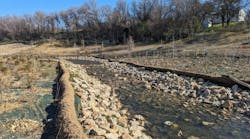Though many associate Los Angeles with its idyllic weather and think of it as far removed from the risk of hurricanes and other dramatic weather events, this region in fact presents significant – and in many ways, unique – water management challenges. Here, the juxtaposition of drought and sudden, extreme rainfall highlights the problem of how to maintain a safe and reliable water infrastructure in the face of changing weather patterns.
Historically, Los Angeles' approach to water management was straightforward: divert stormwater as quickly as possible to prevent flooding. In the 1930s, after some severe storm events, the Los Angeles River was channelized to speed up the release of stormwater to protect the city from future potential flooding. This approach, while effective in tackling the immediate flood risk, ultimately led to new challenges. The growing city saw a significant increase in impervious surfaces, leading to more runoff and lost opportunities for natural water recharge. Today, Los Angeles imports approximately 85% of its water1.
Recent years have seen a paradigm shift in how stormwater is viewed and managed, driven by the increasing severity of weather events due to climate change. Recognizing stormwater as a valuable resource, Los Angeles has begun implementing infrastructure projects designed to capture, clean, and reuse this water – with the aim of creating a more resilient local water infrastructure.
What is resilient water infrastructure?
Resilient water infrastructure refers to systems and processes designed to effectively manage water resources in a manner that ensures sustainability, reliability and durability under a wide range of conditions, including climate change impacts, population growth and urbanization pressures. This concept encompasses the capacity to plan for, recover from, and successfully adapt to adverse events such as droughts, floods and other environmental stressors.
The Argo Drain Project, for which AECOM was the engineer of record, highlights a project that enhances resilient water infrastructure by optimizing stormwater management and use in a densely populated, 2,320-acre area around the Los Angeles International Airport. Argo captures the first 3/4 inches of rainfall with an underground infiltration tank and deep wells. Its comprehensive design includes pre-treatment for trash removal, a pump station, and a clarifier to settle suspended solids, ensuring clean water infiltration or diversion. By investing in this significant project to enhance its water resiliency, Los Angeles now benefits from enhanced stormwater capture capabilities and better treatment and cleaning of water before it is released back into the environment.
Moreover, its emphasis on “multi-benefit” projects underlines the holistic nature of Los Angeles' approach. Such projects not only address water scarcity but also offer additional advantages, such as reducing pollution, creating green spaces, improving public health, and increasing biodiversity. Los Angeles has clearly made strides in enhancing the resilience of its water infrastructure, but as in many communities in the United States and around the world, more remains to be done.
Addressing community needs
A key element of resilience includes addressing the needs of all communities. Unfortunately, underserved communities are often disproportionately impacted by climate events. In areas like California's Central Valley, low-income farmworkers depend on agriculture and are hyper-vulnerable to climate related issues and highly reliant on the water supply. This vital agricultural hub uses 20% of the nation's groundwater despite comprising less than 1% of U.S. farmland2. This immense water demand places a significant strain on local water resources. What’s more, recent research has indicated that since 2019, the rate of groundwater depletion in the Central Valley has been 31% greater3 than the previous two droughts. Depletion since 2003 amounts to about 36 million acre-feet4, roughly 1.3 times the capacity of Lake Mead, the nation's largest reservoir.
Compounding this issue, during periods of drought, the options for obtaining water are limited and costly, disproportionately affecting low-income communities and communities of color. These communities often cannot compete with agribusiness for water resources, leading to wells running dry and exacerbating the problem of inequal water access. Between January 2021 and November 2022, 2,400 dry well reports were filed in the Central Valley5, and this is probably a significant undercount. The accelerated rate of groundwater loss highlights the critical need for immediate and effective implementation of sustainable water management practices.
The Compton Creek Low Flow Diversion Program is a prime example of how infrastructure projects can successfully address these inequities. Situated in a historically underserved area of Los Angeles County, the program aims to divert and treat urban runoff from Compton Creek before it reaches the Los Angeles River, thus preventing pollution from contaminating local waterways. By treating and redirecting this runoff, the project improves water quality and contributes to the community's health and well-being. More projects like these could help with the water quality plaguing many parts of California.
Unique challenges and opportunities in the Golden State
Los Angeles faces unique water management challenges due to its diverse microclimates and extensive geographical spread. The region's varied climate zones, from coastal areas to urban centers and mountainous regions, necessitate highly tailored stormwater management solutions to address specific environmental and urban development needs. This geographic diversity means strategies effective in one area may not be suitable in another, requiring a customized approach to stormwater capture, treatment and reuse to ensure sustainability and resilience across the city and region.
Adding to this complexity, Los Angeles is increasingly at risk of mudslides, exacerbated by a combination of drought conditions, dead vegetation, and impacts from increasing wildfires in the area. These natural disasters are not only a direct threat to lives and property but also complicate water management efforts by altering landscapes and water flow patterns. The importance of stormwater management plays a critical role in capturing and containing runoff, sediment and debris that accumulate from burn areas and increase the risk of mudslides. Moreover, in wildfire-prone areas, implementing specific engineering solutions like building retaining walls and other erosion control features is crucial. These measures help stabilize slopes and protect communities from the devastating impacts of mudslides, illustrating the delicate balance of managing water resources while mitigating natural disaster risks.
Planning for the now and what’s next
The industry has seen the benefits of effective stormwater management and the consequences when effective water management planning and strategies are not considered.
Establishing resilient water infrastructure is highly beneficial to communities everywhere. But what are the specific outcomes of this more resilient approach?
Increased water availability
By implementing advanced stormwater capture and reuse systems, we can help cities mitigate the impacts of drought, ensuring a more sustainable water supply for communities and ecosystems.
Improved management of stormwater runoff during flood events
The innovative designs and solutions that are being implemented in effective water management approaches today reduce the risk of flooding, protecting property and lives while minimizing the economic and environmental costs associated with flood damage.
Enhanced water quality through multi-benefit projects
These holistic projects not only address flood risk and water scarcity but also enhance water quality, contributing to healthier urban waterways and ecosystems.
A meaningful project
The Sites Reservoir project in Northern California is an example of a large project that will meaningfully enhance water infrastructure resiliency in California. Designed to capture excess water from major storms and store it for times of scarcity, it can provide a reliable water supply for communities, farms, and businesses, improve water quality, and contribute to flood management and environmental conservation. It aims to create an additional 1.5 million acre-feet of off-stream storage for these drier periods, and this reservoir will increase the flexibility, reliability, and resiliency of statewide water supplies.
In the future, projects of this nature will become increasingly important and eventually non-negotiable as we consider ways to further strengthen our ability to manage water effectively.
Implementation cannot wait
Advancing stormwater management is crucial to building resilient infrastructure capable of withstanding the impacts of climate change. Millions of Americans face issues related to water scarcity, pollution and other inadequacies. Real action driving innovation, investment, and collaboration in the arena of stormwater management is essential as we seek to safeguard our water resources against the challenge of climate change. Ultimately, this is how we will create a path to reliable and equitable access to our most precious resource, for generations to come.
References:
- https://planning.lacity.gov/eir/WestchesterDEIR/WCUtilities.pdf (LA City Government)
- https://blog.ucsusa.org/marcia-delonge/in-californias-central-valley-drought-is-a-growing-threat-to-farms-food-and-people/ (Union of Concerned Scientists)
- https://www.nature.com/articles/s41467-022-35582-x#:~:text=The%20most%20recent%20phase%20of,the%20long%2Dterm%20depletion%20rate (Nature.com)
- https://www.latimes.com/environment/story/2022-12-22/groundwater-depletion-is-accelerating-in-the-central-valley#:~:text=They%20also%20found%20that%20groundwater,Vegas%2C%20the%20country's%20largest%20reservoir (LA Times)
- https://www.foodandwaterwatch.org/2023/03/07/in-spite-of-recent-rain-californias-central-valley-water-wells-are-drying-up/#:~:text=2021%20to%20Nov.,self%2Dreporting%20to%20the%20state (Food & Water Watch)






